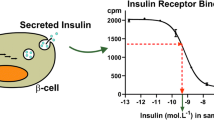Abstract
Recent studies have reported that elevated proinsulin levels are indicative of an increased cardiovascular risk. Renal proximal tubular cells represent a major site for the metabolism of insulin-like hormones after glomerular filtration into the tubular lumen. To determine the binding and degradation of proinsulin in comparison with insulin and insulin-like growth factor-1 (IGF-1), we have used a rabbit proximal tubular cell line (PT-1). As confirmed by electron microscopy, PT-1 cells exhibit bipolar differentiation, demonstrating apical microvilli and invaginations of the basolateral membrane. To allow selective incubation of both compartments, cells were grown on filter membranes. Performing equilibrium binding assays with125I-labelled hormones, severalfold higher binding was found at the apical than at the basolateral cell membrane, with the capacity range IGF-1>insulin>proinsulin. Half-maximal displacement of125I-labelled insulin and IGF-1 was observed at 0.6 and 2 nM, respectively, while crossover binding to the alternate receptor occurred with a 10- to 100-fold lower affinity. Half-maximal displacement of125I-proinsulin binding was obtained at approx. 8 nM proinsulin and insulin, whereas IGF-1 was 10-fold less potent. The relative degradation of specifically bound tracer was lowest for proinsulin (apical: 10%, basolateral: 13%). IGF-1 was degraded by 20% at the apical cell membrane, and up to 78% at the basolateral membrane. In contrast, almost the total amount of insulin bound was degraded at both membrane sites (apical: 99%, basolateral: 83%). These results suggest separate insulin and IGF-1 receptors, while proinsulin binds with high affinity to a third insulin-like receptor on the apical membrane of PT-1 cells.
Similar content being viewed by others
References
Rinderknecht E, Humbel RE, The amino acid sequence of human insulin-like growth factor I and its structural homology to proinsulin. J Biol Chem 253:2769–2776, 1978
De Meyts P, The structural basis of insulin and insulin-like growth factor-I receptor binding and negative co-operativity, and its relevance to mitogenic versus metabolic signalling. Diabetologia 37 [Suppl 2]:135–148, 1994
Podlecki DA, Frank BH, Olefsky JM, In vitro characterization of biosynthetic human proinsulin. Diabetes 33:111–118, 1984
Rausch UW, Fussgaenger RD, Heinze E, Qualitative dissimilarities of insulin and proinsulin binding and action in vitro at IM-9 lymphocytes. Horm Metab Res Suppl 1/88:88–92, 1988
Nissley SP, Rechler MM, Moses AC, Short PA, Podskalny JM, Proinsulin binds to a growth peptide receptor and stimulates DNA synthesis in chick embryo fibroblasts. Endocrinology 101:708–716, 1976
Schneider DJ, Nordt TK, Sobel BE, Stimulation by proinsulin of expression of plasminogen activator inhibitor type-1 in endothelial cells. Diabetes 41:890–895, 1992
Nordt TK, Schneider DJ, Sobel BE, Augmentation of the synthesis of plasminogen activator inhibitor type-1 by precursors of insulin. A potential risk factor for vascular disease. Circulation 89:321–330, 1994
Duckworth WC, Kitabchi AE, Direct measurement of plasma proinsulin in normal and diabetic subjects. Am J Med 53:418–427, 1972
Cohen RM, Nathan DM, Clements RS, Hyperproinsulinemia in type II diabetes. Diabetes Care 15:723–724, 1992
Revers RR, Henry R, Schmeiser L, Schmeiser O, Koltermann R, Cohen R, Bergenstal R, Polonsky KS, Jaspan JB, Rubenstein AH, Frank B, Galloway J, Olefsky JM, The effects of biosynthetic human proinsulin on carbohydrate metabolism. Diabetes 33:762–770, 1984
Hammerman MR, Interaction of insulin with the renal proximal tubular cell. Am J Physiol 249: F1-F11, 1985
Talor Z, Emmanouel DS, Katz AI, Insulin binding and degradation by luminal and basolateral tubular membranes from rat kidney. J Clin Invest 69:1136–1146, 1982
Yagil C, Frank BH, Rabkin R, Internalization and catabolism of insulin by an established renal cell line. Am J Physiol 254: C822-C828, 1988
Frank BH, Beckage MJ, Willey KA, High-performance liquid chromatographic preparation of single-site carrier-free pancreatic polypeptide hormone radiotracers. J Chromatography 266:239–248, 1983
Cheng YC, Prusoff WH, Relationship between the inhibition constant (Ki) and the concentration of inhibitor which causes 50 per cent inhibition (IC50) of an enzymatic reaction. Biochem Pharmacol 22:3099–3108, 1973
Hintz RL, Thorsson AV, Enberg G, Hall K, IGF-II binding on human lymphoid cells: Demonstration of a common high affinity receptor for insulin-like peptides. Biochem Biophys Res Commun 118:774–782, 1984
Jonas HA, Cox AJ, Insulin receptor subtypes in a human lymphoid-derived cell line (IM-9): Differential regulation by insulin, dexamethasone and monensin. J Recept Res 11:813–829, 1991
Blazer-Yost BL, Watanabe M, Haverty TP, Ziyadeh FN, Role of insulin and IGF1 receptors in proliferation of cultured renal proximal tubule cells. Biochim Biophys Acta 1133:329–335, 1992
Fussgaenger RD, Ditschuneit HH, Martini H, Wiebauer-De Lenardis H, Etzrodt H, Thun CH, Ditschuneit H, Pfeiffer EF, Enzmann F, Potency of biosynthetic human insulin determined in vitro. Diabetes Care 4:228–234, 1981
Jehle PM, Lutz MP, Fussgaenger RD, High affinity binding sites for proinsulin in human IM-9 lymphoblasts. Diabetologia 39:421–432, 1996
Rubenstein AH, Pottenger LA, Mako M, Getz GS, Steiner DF, The metabolism of proinsulin and insulin by the liver. J Clin Invest 51:912–921, 1973
Kitabchi AE, Proinsulin and C-peptide: a review. Metabolism 26:547–587, 1977
Zapf A, Hsu D, Olefsky JM, Comparison of the intracellular itineraries of insulin-like growth factor-I and insulin and their receptors in rat-1 fibroblasts. Endocrinology 134:2445–2452, 1994
Nagi DK, Hendra TJ, Ryle AJ, Cooper TM, Temple RC, Clark PMS, Schneider AE, Hales CN, Yudkin JS, The relationships of concentrations of insulin, intact proinsulin, and 32–33 split proinsulin with cardiovascular risk factors in type 2 (non-insulin-dependent) diabetic subjects. Diabetologia 33:532–537, 1990
Haffner SM, Mykkänen L, Stern MP, Valdez RA, Heisserman JA, Bowsher RR, Relationship of proinsulin and insulin to cardiovascular risk factors in nondiabetic subjects. Diabetes 42:1297–1302, 1993
Reaven GM, Role of insulin resistance in human disease (syndrome X): an expanded definition. Annu Rev Med 44:121–131, 1993
Author information
Authors and Affiliations
Rights and permissions
About this article
Cite this article
Jehle, P.M., Fußgänger, R.D., Stracke, S. et al. Different binding and degradation of proinsulin, insulin and insulin-like growth factor-1 (IGF-1) in cultured renal proximal tubular cells. Acta Diabetol 33, 159–165 (1996). https://doi.org/10.1007/BF00569428
Received:
Accepted:
Issue Date:
DOI: https://doi.org/10.1007/BF00569428




